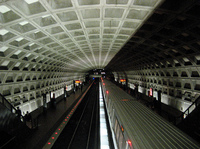Metro staff propose service cuts
At yesterday’s Finance Administration and Oversight working meeting, WMATA chief John Catoe and Chief Financial Officer Carol Kissal discussed potential “service adjustments”, i.e. service cuts, in order to close the remaining $73M budget hole for the 2010 fiscal year, which starts July 1.
During the previous FAO meeting, the Board committee instructed Metro staff to change some assumptions in the budget. Staff had estimated some revenues and expenses conservatively, and the Board told them to make their best guesses instead of erring on the side of caution. That closed some of the budget gap. Some of the adjustments are:
- Assume $5M more revenue from the elimination of bus transfers due to the reduction in fraud.
- Assume $1.2M more revenue from renting space for fiber optic telecommunications lines.
- Defer funding WMATA’s unfunded health insurance fund by $4M for an additional year.
- Use $10M more in available Federal capital funding to perform capital-like operating maintenance expenses. This would take money from capital funding which would either have to be replaced or WMATA would reduce the ability to invest in the future.
- Save $7M this year based on smoothing pension liabilities over a 5-year period as opposed to a 3-year period. David explored this in a previous post.
- Cut $12M based on “wage settlement”, which was not discussed in the handout, but could be the result of negotiations between WMATA and its transit unions. The FAO Committee has been holding executive (closed) session meetings with union negotiations as the stated topic of discussion, so it will likely be the results of these meetings.
If some of these assumptions turn out to be wrong, it’s unclear what the fix would be. It’s possible in that situation WMATA could pass a mid-year fare increase, could cut back on service, place employees on involuntary leave, or request more money from jurisdictions.
After these and other changes, WMATA’s budget shortfall is $28.8M for the year, about a third of the shortfall from FY 2009 that required large fare increases in January of last year.
From there, WMATA staff proposed various service cuts. First, to save $10M they proposed eliminating some bus routes that “duplicate” other bus service. These don’t entirely duplicate each other but are merely lines that parallel each other for some distance:
- DC: Eliminate the 60 (Ft. Totten-Petworth) while keeping the 64; the L4 (Connecticut Ave) while keeping the L1 and L2; the N3 (Massachusetts Ave) while keeping the N2, N4, and N6; and the P2 (Anacostia-Eckington) while keeping the P1 and P6. Shorten the 42 bus between McPherson and Metro Center, and the 80 between McPherson and the Kennedy Center. Metro will also cut buses that serve schools. Last year the FTA limited transit agencies’ ability to provide special bus service for schools in an effort to prevent federally subsidized transit agencies from competing with charter buses. The school bus cuts are all ones forced by the new FTA rules.
- MD: Eliminate the C4 (Greenbelt-Twinbrook) west of Wheaton; the C8 (College Park-White Flint) off-peak and Saturday; the L7 (Connecticut Avenue) while keeping the L8; the P17 & P19 (Oxon-Hill-Fort Washington) beyond Southern Avenue; the W13 & W14 (Bock Road) beyond Southern Avenue; and the J3 (Bethesda-Silver Spring) while keeping the J1 and J2.
- VA: Cut back the 9A (Huntington-Pentagon) after 11 pm; cut back the 10A (Hunting Towers-Pentagon) after 9 pm and entirely on weekends, while keeping the 10E; eliminate the 18R & 18S (Burk Center) while keeping the 18P; and cut back service on the 28A& 28B (Alexandria-Tysons Corner) between King Street and the NVCC.
Next, to save $3.3M, they proposed widening headways (time between vehicles) on buses. As part of this change, WMATA assumed no loss of ridership and therefore no loss of revenue. That’s unlikely. With fewer buses, some people will inevitably switch from transit to driving or other modes.
They propose saving $7.5M by reducing the frequency of trains:
- Less frequent service between 6 and 7am
- 15 minutes between trains from 6:30 to and 9 pm and 20 minutes from 9 to midnight
- Less frequent service during mid-day, probably 15 minutes between trains
- 15 minutes between trains on Saturdays from 10 am to 6 pm
Last, Metro would close some additional station entrances on weekends and earlier on weekdays, saving $700K.
The total savings for all the described service cuts is $21.4M, leaving only $7.4M of budget gap out of an over $500M subsidy.
From here, it’s possible that WMATA could do any of three things. They could send the $7.4M out as a request for increased subsidy. After all, it’s only about 1.5% of the budget. They could figure out a minor fare increase; approximately ten cents on rail or bus would probably do it. Or, they could come up with additional service cuts. Considering that $7.4M is about a third of the cuts they already made, the rest of the cuts would likely be to service that affects even more riders, an undesirable situation.
After these cuts and “service adjustments”, we’re getting very close to having a workable budget. The WMATA board meeting is next Thursday, February 26. I don’t think that any potential service cuts would be in a form ready for the Board to authorize public hearings at that time, but we’re getting close.
Note that the WMATA board doesn’t endorse these proposals, and really had no opportunity to vet these through their staffs before they were presented. These are WMATA staff proposals, not what the Board is endorsing.
According to the Examiner, Board members were pleased that staff have been able to plug the gap with fewer cuts, but want to see still more revenue increases or cost savings. Jim Graham suggested putting retail in the stations, charging for parking on weekends, and cutting some money from MetroAccess, which has no reductions in the proposed budget.

